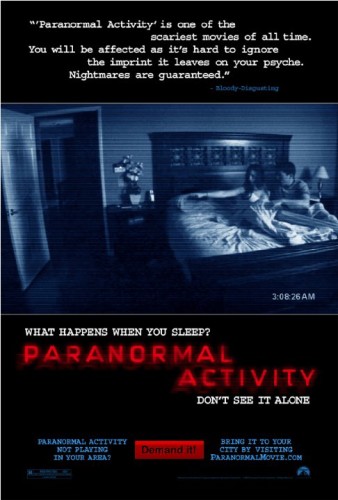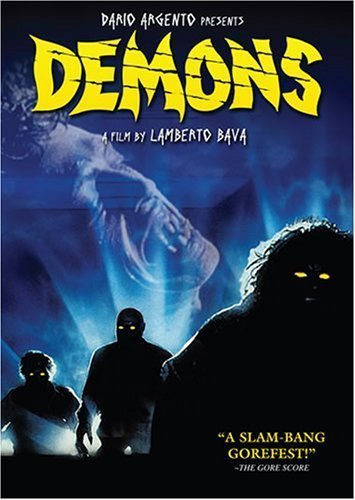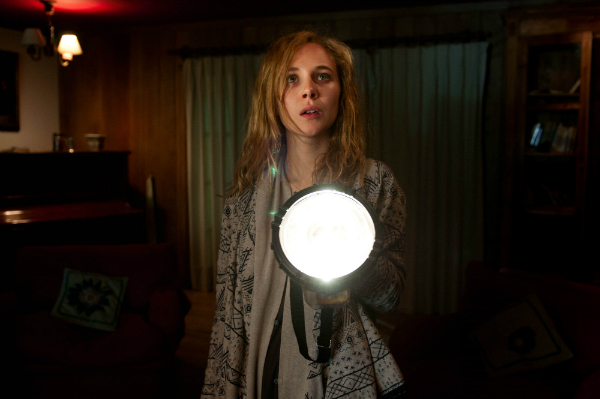This guest post by Alexandra West appears as part of our theme week on Demon and Spirit Possession.
Oren Peli’s Paranormal Activity became a worldwide sensation and one of the most profitable films ever made. Shot in 2007 but not officially released until 2009, the independent film made its mark on filmgoers and helped popularize the found footage horror format which began with the likes of Cannibal Holocaust (1980) and The Blair Witch Project (1999). After filming was completed, director Oren Peli had it tour the festival circuit where it generated a fair amount of buzz. Universal acquired it and the film languished in development hell. There were talks of a full-on remake doing away with the found-footage aspect and turning it into a traditional narrative with celebrities starring. But it would be Steven Spielberg who saw the film while Universal and Dreamworks were figuring out what to do with it and he suggested leaving it as it was, but re-film the ending so that it was open-ended and sequel ready.
The film opens with a couple, Micah (Micah Sloat) and Katie (Katie Featherston) who live together and are “engaged to be engaged”. Strange things have been happening in the house so Micah decides to take control over the situation and buy a camera to capture the events and determine the culprit. Katie invites a psychic over and tells him things like this have been happening to her since she was little. Things begin to escalate with the cameras capturing not only supernatural occurrences but also the deterioration of Micah and Katie’s relationship. Then the demon takes control.
In Laura Mulvey’s ground-breaking essay “Visual Pleasure in Narrative Cinema,” she posited the idea of the “male gaze.” Looking closely at cinema from the 1930 through 1960s, Mulvey traces a pattern of fetishizing the female body, the camera examining and idolizing it which created an objectification of the body engendering the gaze as decidedly male. This creates the idea of woman as object rather than a human being with her own thoughts, concerns and motives. She is held captive by male desire. As Mulvey writes, “The alternative is the thrill that comes from leaving the past behind without rejecting it, transcending outworn or oppressive forms or daring to break with normal pleasurable expectations in order to conceive a new language of desire.” Mulvey’s essay was published in 1975 and has gone on to become a staple of film studies course and film criticism.
Paranormal Activity, for the first half, is completely submerged in the male gaze. Micah’s camera picks up what he wants to see and what he demands of his only consistent participant, Katie. As the film begins, the unexplained incidents–which are the catalyst for Micah purchasing the camera–are dispersed with the couple’s normal life; Katie is annoyed at Micah following her around and filming her, Micah goads Katie for sex and brags about it and in one instance, when Katie is in the washroom, she screams. Micah runs for the door, pauses, returns to get the camera, and then runs to check on Katie. Katie, having been scared by a large spider in this case, surmises that Micah went and got the camera before helping her. His need to capture all the events that pass that could explain away Katie’s fear is surpassing his instinct to actually help her.
The tone of the film begins to shift when Katie invites a psychic over to help. Katie says this isn’t the first time this has happened to her as she was visited by something as a child and she’s worried that it’s all happening again. Micah continually scoffs at the psychic, making it clear that he’s threatened by his girlfriend turning to someone else for help rather than him. The psychic agrees with Katie that something is going on and that it has been following Katie for all these year. He fears that it is demonic, meaning it wants to possess Katie. The psychic also warns that constant filming and playing with this entity is inviting it in, encouraging it to enter their world. He gives Katie the number of a demonologist and tells her to get in contact with him. While Katie feels she finally has answers, Micah convinces her that it’s nothing he can’t figure out. Katie agrees to forgo calling the demonologist for the time being.
Some of Paranormal Activity’s most iconic scenes are of the couple sleeping. Micah sets the camera on a tripod and the film shows us a time-lapse version of them sleeping. The first few nights reveal small occurrences such as the door to the bedroom moving slightly though no windows in the house are open. Micah pores over the footage, reveling in the fact that he’s onto something and catching it all on camera.
The film takes a stark turn. Katie is sleeping less and less, weakening her and putting a strain on her and Micah’s relationship. They decide to go out one night. Before they leave, Micah sets up a Ouija board to try and communicate with the entity. Katie walks in on him setting it up and angrily tells him that this is exactly what the psychic told them not to do. As she storms off, Micah follows, leaving the camera filming the Ouija board. The camera captures the Ouija board moving on its own and eventually bursting into flames which extinguish on their own. The events escalate with Katie being pulled out of bed by an unseen force and bite marks appearing on her back. Micah, determined to make things right, decides to get them out of the house though they have been told the demon will follow. Before they leave, Katie tells him that they should stay. Micah, frustrated, says fine, leaving the camera behind to catch an eerie grin on Katie’s face. On the final night Katie gets up from bed, goes downstairs and screams. Micah runs to help her and several loud thumps are heard. Katie returns to their bedroom, hurls Micah’s body at the camera crawling toward the camera and in the final moments of the film, her face morphs into something demon-like. The epilogue text states that Micah’s body was found a few days later and that Katie is still missing.
The gaze of the film is subverted from the first night they film themselves sleeping. It is the demon’s entrance into their lives. Though Katie says she experienced something similar as a child, Micah’s involvement causes it to grow worse. The film becomes terrifying because the audience knows Micah is no longer in control. As he says in the film, “I’ve been doing my research. I’m taking care of this. Nobody comes in my house, fucks with my girlfriend, and gets away with it.” Micah’s insistence on controlling the situation is precisely what allows it to escalate. Rather than heed the psychic’s warning, Katie trusts Micah and leaves herself open and vulnerable to the external entity. The film takes a decisive turn after the Ouija board scene. The demon has become more powerful and is wreaking havoc on their lives. No longer are we viewing this world through Micah’s male gaze, we are viewing it through a demonic gaze. The biggest similarity between Micah’s gaze and the demonic gaze is that Katie is the subject. She is either being followed by Micah’s camera or the demon. The only time she takes control of the narrative, first by getting Micah to stay in the house and then by killing him, is when she is possessed.
Mulvey posited that something radical must shift in film to escape the dominant male gaze toward a more equalized gaze. While the film industry’s awareness of the lack of complicated female characters, female directors, and writers is growing there is still work to be done. Paranormal Activity is a fascinating examination of this shift, though not ultimately a successful one. Micah’s patriarchal control through the first half of the film is omnipresent as he mocks, coerces and films his girlfriend’s descent into possession. The second half of the film deals with the demon taking control of the film. Micah and Katie are too weak to properly deal with the situation and they lose sight of their safety. The audience see what the demon wants them to see; it is in control of not only Katie’s mind and body, but also what the audience is exposed to, creating an unstable and terrifying experience.
Katie’s only real power comes when she is possessed. Because Micah isolated them, he has no one to protect him. Katie who ultimately kills him and throws his body into a camera knocking it over and creating a Dutch Angle within the film and skewing the look and feel of the night-vision sleeping arrangement that the audience has become so used to throughout the film, signalling the dawn of something new that we are perhaps not ready to see quite yet. Katie’s (or what used to be Katie) greatest act of defiance is escaping the camera view. In the final moment of the film, “Katie” lunges at the camera and it goes black before the final text appears. All the audience knows is that she is gone and has escaped the camera’s gaze. It is no longer able to monitor her.
Paranormal Activity achieved a shift by mocking Micah’s machismo. His comments and actions when he is control fail to protect either of them. Film fans recognize the trope in horror films of not heeding direct warnings, which leads characters to danger. Micah’s male gaze is so out of control that he convinces Katie to ignore the help they have been given until it is too late. His hyper-masculinity is so performative that the audience can’t help but be weary of him and his intentions. Micah partially succeeded in his goal which was finding out the cause of the disturbances but failed because the answer was only revealed because the demon let it.
Alexandra West is a freelance horror journalist and playwright who lives, works, and survives in Toronto. Her work has appeared in the Toronto Star, Rue Morgue, Post City Magazine and Offscreen Film Journal. She is a regular contributor to Famous Monsters of Filmland and a columnist forDiabolique with “The Devil Made Us Watch It.” In December 2012, West co-founded the Faculty of Horror podcast with fellow writer Andrea Subissati, which explores the analytical side of horror films and the darkest recesses of academia.





















